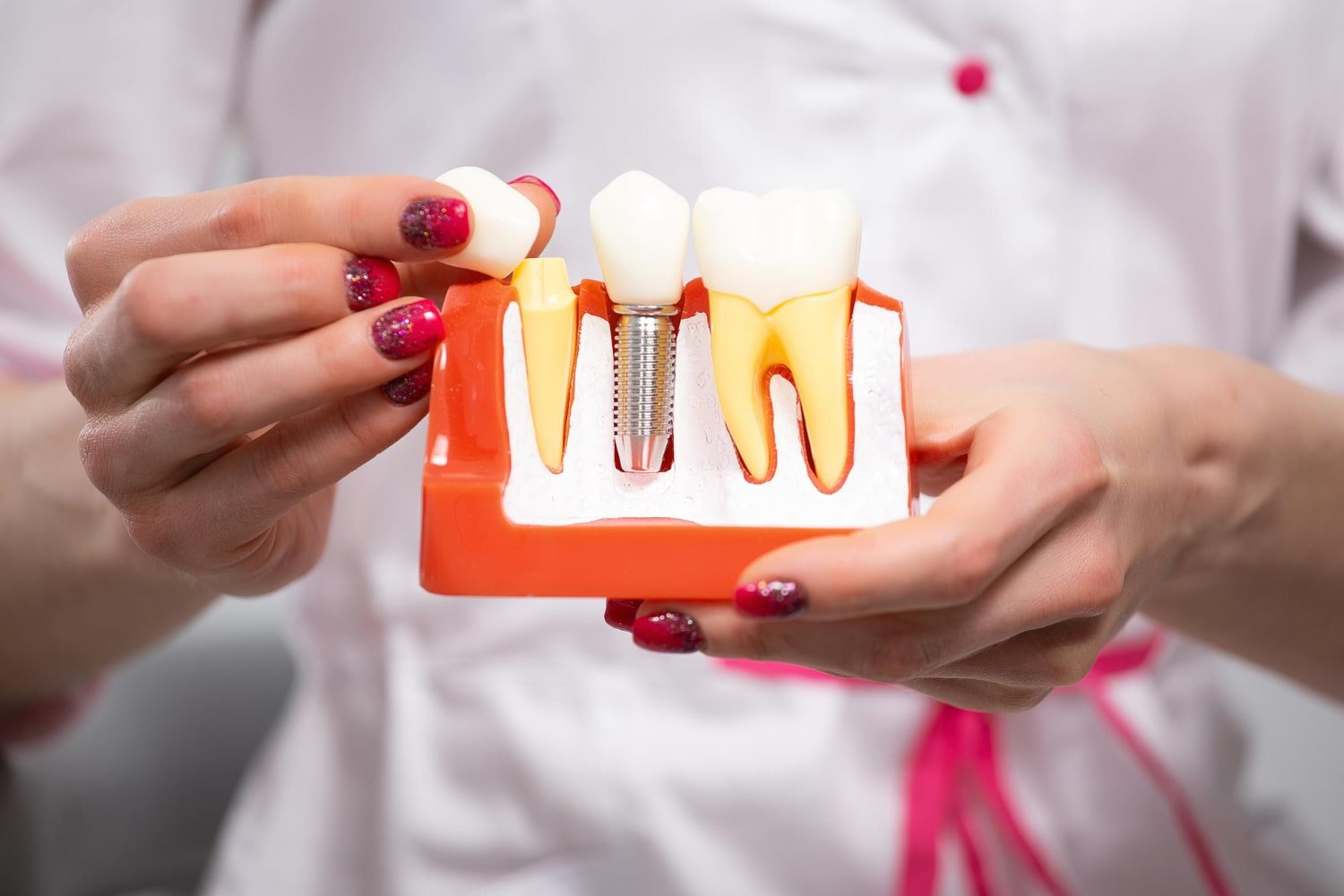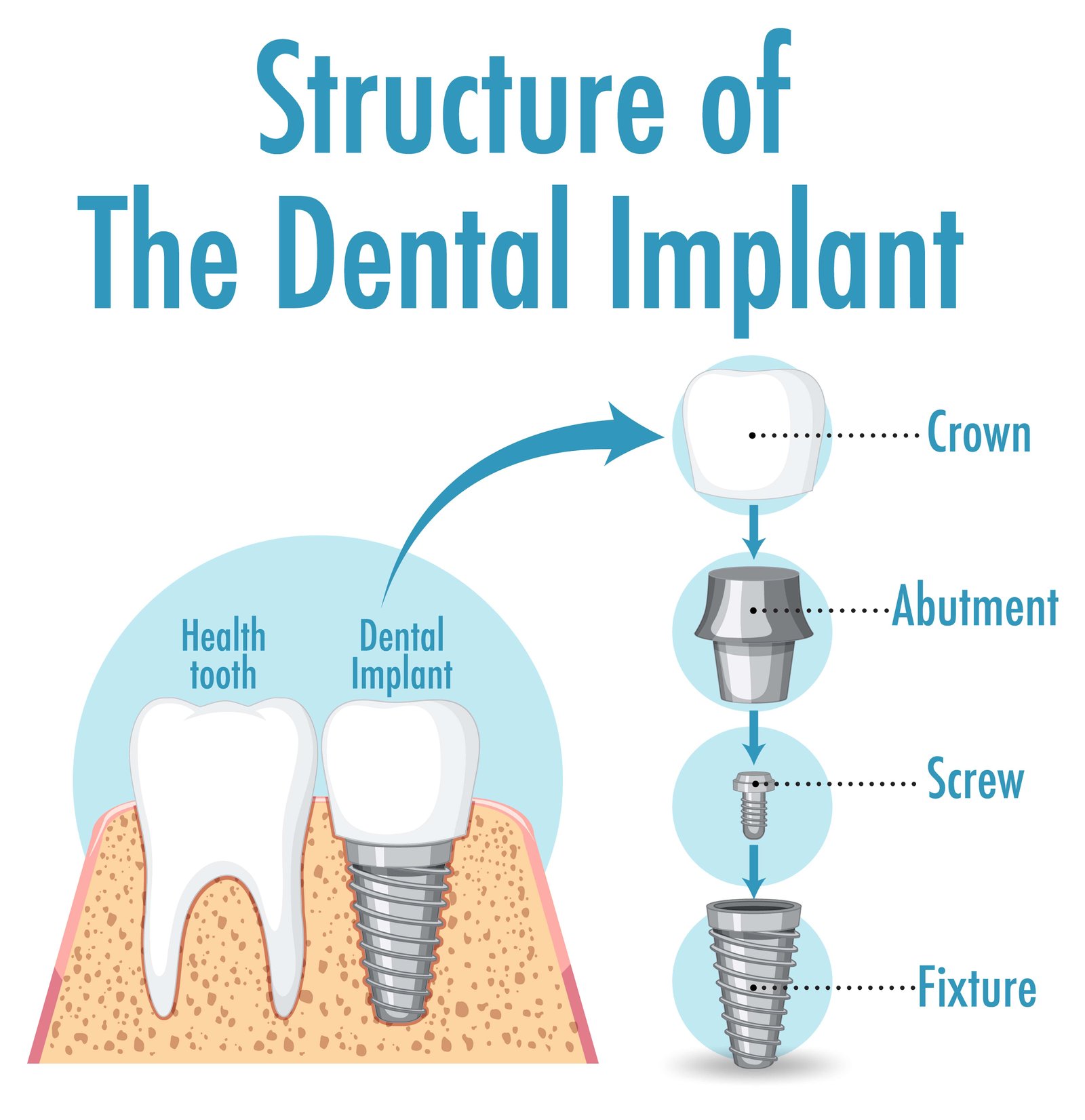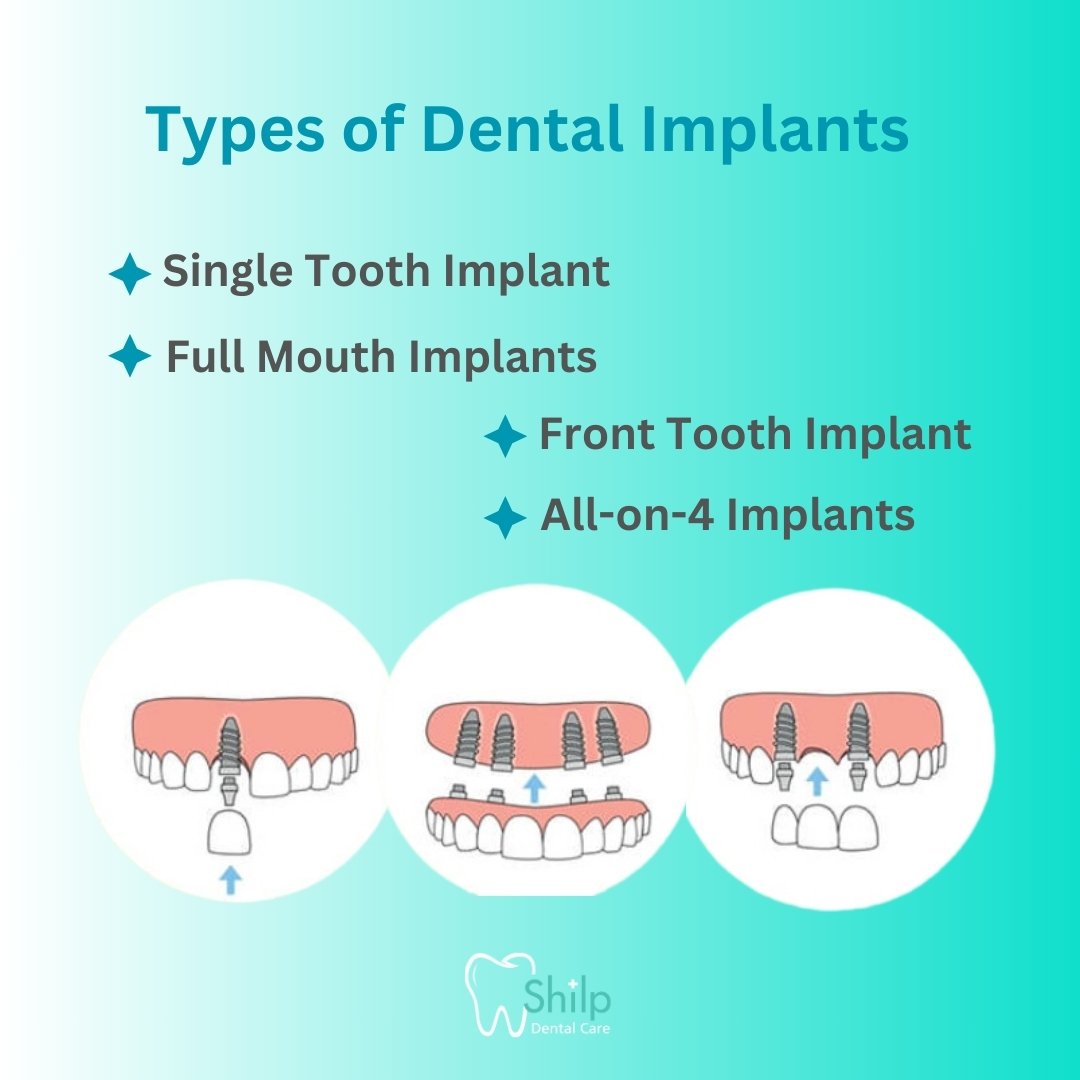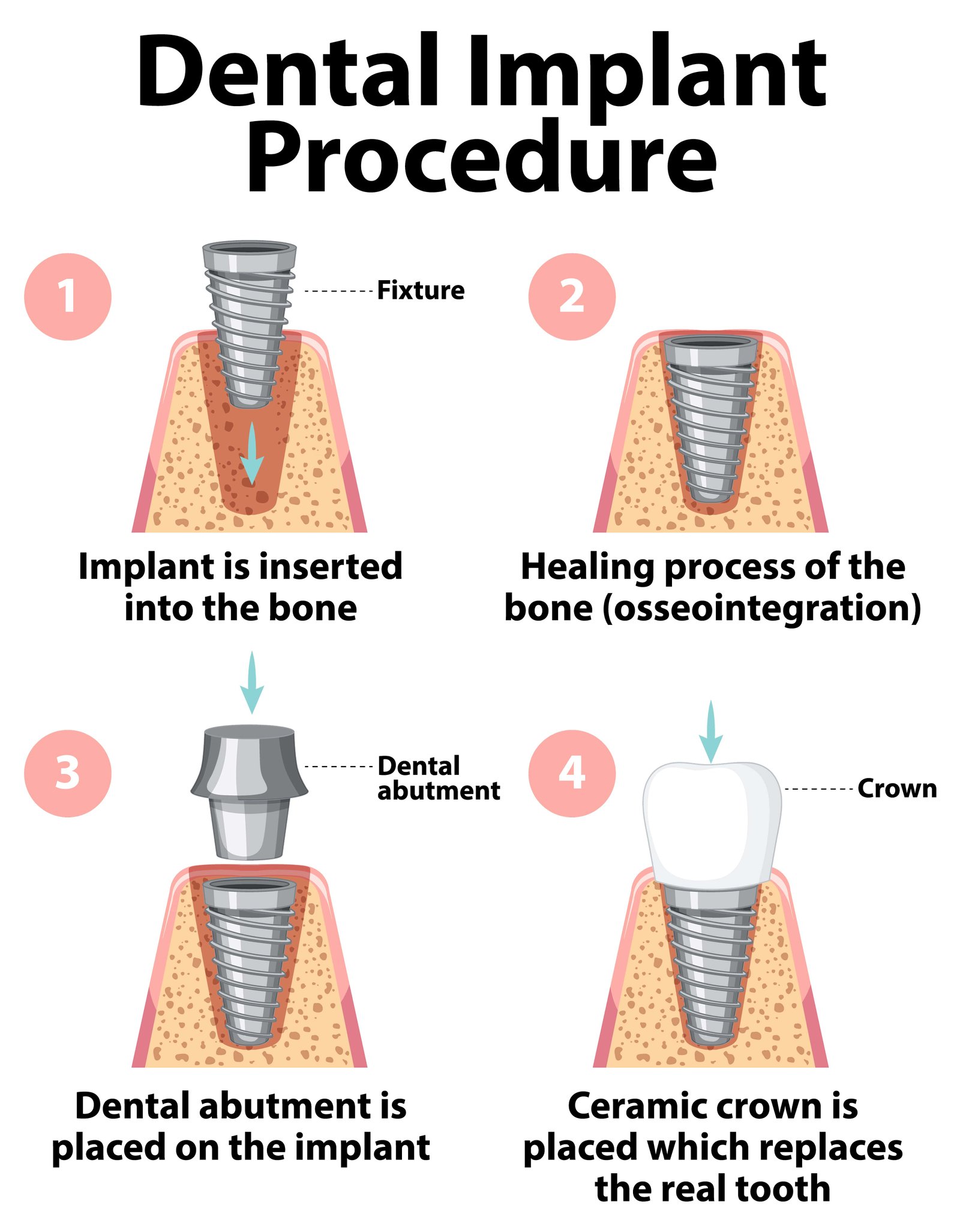
Dental implants are cutting-edge medical technology intended to help people who have lost teeth regain both function and appearance. These implants are surgically inserted into the jawbone and offer a reliable base for dental prosthetics including crowns, bridges, and dentures. Beyond just filling gaps, dental implants play a crucial role in improving a person's ability to chew, speak, and maintain a natural-looking smile. In this blog, we will delve into all aspects of dental implants, covering their benefits, the procedure itself, as well as post-care and maintenance tips. Whether you're considering dental implants or just curious about this advanced dental solution, read on to discover how they can transform your oral health and quality of life.
When a tooth is lost due to an accident or disease, a person may suffer problems such as rapid bone loss, poor speech, or changes in chewing patterns that cause discomfort. Replacing a missing tooth with a dental implant can greatly enhance a patient's quality of life and health.
A dental implant system consists of a dental implant body and an abutment, which may additionally comprise an abutment fixation screw. The dental implant body is surgically placed in the jawbone to replace the tooth's root, making it a core component of what dental implants are. The dental implant abutment is connected to the implant body using a small screw. It extends above the gums into the mouth, providing support for the artificial teeth attached to it.

Standard dental implants can replace lost teeth while maintaining jawbone structure. They are made up of three main components that closely resemble actual teeth. These implants are a popular choice among dentists and patients because, with appropriate care, they can last a lifetime.
Natural teeth are hard, calcified structures that protrude over the gum line and are attached to the jawbone by roots. Dental implants consist of three major components that replicate the following functions:The first and most important stage in the implant process is the surgical implantation of a titanium or zirconium post. This post, which resembles a screw or cylinder, is placed where the tooth's natural root previously existed. The metals utilised for the posts are strong and easily absorbed by the human body. Once the post is inserted into the jaw, it starts to fuse with the surrounding bone, forming a strong base for the artificial tooth. This process, known as osseointegration, might take between three and six months.
After the post has fused with the jaw, the dentist installs the abutment. The post's head, which the abutment is positioned on, is visible after the dentist creates a little incision. Made of titanium or zirconium that matches the colour of the tooth, the abutment joins the artificial tooth to the post. This phase of the treatment requires up to six weeks of recuperation. Although the abutment has no anatomical equivalent, it is required for attaching prosthetic teeth to dental implants.
The prosthetic tooth or dental crown is placed as the final step in the dental implant process. Crowns can be cemented or screwed onto the abutment. They may be made of porcelain, metal, or resin.
Crowns that are affixed to the abutment are incredibly stable and won't move. On the other hand, overuse of cement may result in seepage beneath the gum line, which may induce an allergic reaction or infection. Although cemented crowns are stable and can be challenging to remove for repairs, they offer patients confidence when they chew.
Explore the various materials that are available for your dental implants. Every choice has its advantages, whether you're thinking about the durability of metal teeth, the aesthetic appeal of ceramic teeth, or the natural look of porcelain teeth. Learn about their qualities and choose the one that best satisfies your demands for a seamless smile, strength, and durability.
Dental implants are classified into three types: endosteal, subperiosteal, and zygomatic. Each type is designed to meet certain demands and conditions. Let's explain them in simpler terms:
Endosteal implants are the most popular and reliable form of dental implant. They look like little screws and are inserted straight into the jawbone. This type of implant serves as a solid basis for prosthetic teeth like crowns and bridges. After the implant is placed, it requires time to heal and fuse with the jawbone. Once healed, your fake teeth can be connected to match your real teeth.
Subperiosteal implants are an option for those who do not have enough healthy jawbones for endosteal implants or who do not want to go through major surgery. These implants are positioned on top of the jawbone but behind the gum. Posts protrude through the gums and a metal frame is positioned beneath the gums. As the gums recover, they hold the frame in place. The prosthetic teeth are then affixed to these posts.
The most complicated and uncommon type is zygomatic implants. Instead of being placed in the jawbone, these implants are attached to the cheekbone (zygoma). This kind is utilised when there is insufficient jawbone for other implants and significant bone grafting is not feasible.

Your dentist can assist you in selecting the most suitable dental implant solution for your needs. Here are some of the most commonly chosen types:
This option is used to replace the single missed tooth. Single Tooth Implant
involves placing one implant and attaching one crown, filling the gap seamlessly.
Replacing a front tooth is typically more difficult since it must appear natural and integrate with your other teeth. In front tooth implants, precise placement is essential to achieve the finest cosmetic results.
Full mouth implants can be the best solution if you are missing most or all of your teeth. This requires a full mouth restoration, including several implants and crowns. Sometimes, bone grafts are needed to provide a strong foundation.
This method includes surgically placing four implants in the jaw to support a full set of dentures. All-on-4 implant is appropriate for individuals with low bone density as it provides superior stability and support.
No matter what type of dental implant you require, your dentist will work with you to ensure the greatest possible outcome, restoring both function and appearance to your smile.

Dental implant surgery typically involves several stages over a few months, with healing time between each. Here’s a concise overview:
Team Involvement: Oral surgeon, periodontist, prosthodontist, and sometimes an ENT specialist.
Preparation: Includes dental exams (3D images, X-rays), medical history review, and creating a personalized treatment plan.
Anesthesia Options: Local, general, or sedation anaesthesia. Arrange for post-surgery transportation if needed.
Insertion: A titanium post is placed into the bone socket of the missing tooth.
Procedure: An incision is made, the post is inserted, and bone healing may take 6 weeks to several months.
Optional Bone Grafting: Might be needed if the jawbone is insufficient; recovery can take several months.
Process: After the implant fuses with the jawbone, an abutment is attached. This may involve reopening the gums, attaching the abutment, and sealing the gums around it.
Recovery: Gums usually heal in about two weeks.
Crown Creation: Impressions are taken to make a crown that matches your natural teeth.
Options: Removable (like dentures) or fixed (screwed or cemented to the abutment). Multiple teeth can be replaced with a single implant if bridged.
Common Discomforts: Swelling, bruising, pain, and minor bleeding. Follow up with pain management and contact your surgeon if symptoms worsen.
To ensure the success and longevity of your dental implant:
Explore the step-by-step procedure of dental implants, from your initial consultation to the final stages of recovery. Learn what happens at each stage of your journey to a brighter smile.
Understanding the different types of dental implants and their costs is crucial when considering your options. Here are the three key types of dental implants and their average costs in Ahmedabad:
|
Type of Dental Implant |
Average Cost in Ahmedabad |
|
Endosteal Implants |
₹15,000 to ₹50,000 (varies by facility and needs) |
|
Subperiosteal Implants |
₹15,000 to ₹40,000 (due to intricate design) |
|
Zygomatic Implants |
₹60,000 to ₹1,50,000 (complex surgery and case variations) |
Curious about the cost of dental implants and how to manage expenses? Explore our in-depth overview of dental implant costs, factors influencing pricing, and tips for financial planning.
Dental implants might be costly, however, there are several financing solutions available to make them more affordable:
Investing in your dental health is important. To learn more about dental implant costs and how to manage expenses, read our detailed guide.
There is minimal discomfort associated with dental implants. Local anaesthesia eliminates pain throughout the operation, which normally lasts two hours for the first session and one hour for crown fitting. Mild gum aching may develop following treatment, which can be managed with over-the-counter pain medications. Sedation methods are available to enhance patient comfort throughout the treatment.
Are dental implants safe? They can last a lifetime and are generally seen to be safe, especially when prescribed by a dentist. The FDA certifies that the materials used in dental implants adhere to global safety regulations. They might not be appropriate for everyone, though, including smokers and people with gum disease, autoimmune disorders, or certain allergies. While issues such as dental implant infections or dental implant failure are possible, many individuals consider dental implants to be a secure and effective solution for missing teeth.
At Shilp Dental Care, Dr Vandil Patel prioritises patient safety with rigorous sterilization and infection control measures to prevent complications like infections during dental procedures. You'll receive detailed instructions on how to keep your mouth clean and schedule periodic checkups after your implant procedure. These routine examinations are crucial for keeping an eye on your implants, making sure they're working properly, and spotting any problems early on.
Yes, it is possible to save an infected dental implant. Due to peri-implantitis, infections can result in inflammation and bone loss around the implant. This disorder affects the gum tissues and surrounding bone of the implant, much like gum disease.
Dental implant surgery has become renowned for its safety and predictability, with a high success rate. With meticulous planning and thorough consultations, our skilled professionals at Shilp Dental Care guarantee excellent outcomes. However, it's important to note potential side effects, including dental implant failure, which can occur despite our best efforts to mitigate risks.
Despite this, most patients have minimal discomfort and get satisfactory outcomes with their dental implants.
Dental implants have become a popular choice for replacing missing teeth due to their numerous benefits. However, they also come with certain drawbacks. Understanding both the pros and cons of implants can help you make an informed decision about whether implants are the right option for you.

Thinking about dental implants or want to explore your options? Book a consultation at Shilp Dental Care. We’ll examine your teeth, discuss your needs, and explain everything in detail. Our friendly and professional team is here to help you achieve the smile you have always wanted.
Schedule your consultation today and take the first step towards a bright, confident smile. We create beautiful smiles with care and precision.
Sign up with your name and email to get updates fresh updates.